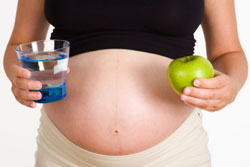Introduction
Macronutrients are nutrients such as protein and carbohydrates which are converted into energy, to be used by the body to fulfil essential functions and perform physical tasks. They are obtained from a variety of food sources including cereals and grains, meat and legumes. During pregnancy macronutrients provide the energy necessary for foetal growth and maintenance of the woman’s weight and essential bodily functions (e.g. respiration). Macronutrient requirements therefore increase during pregnancy because the growing baby requires energy as well as the woman’s body. Ensuring energy intake increases accordingly is essential for optimal health outcomes for both the pregnant woman and her baby.
Health risks associated with inadequate macronutrient intake
An individual who does not consume enough energy becomes malnourished, and malnutrition has a range of health consequences for a pregnant woman and her growing baby. These include a greater risk of low-birth weight and infant mortality. Low birth rate is the most important factor which causes illness and death in babies. It is also associated with a variety of infant and childhood development disorders, in particular poor cognitive (mental) development. Low birth weight also increases an individual’s risk of developing chronic health conditions such as diabetes later in life.
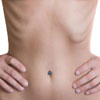 |
More information on the health risks associated with Under-Nutrition Before and During Pregnancy. |
Why a pregnant woman’s macronutrient requirement is increased
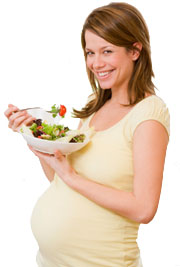
- Maintain the woman’s essential body functions such as respiration and digestion of food. The energy expended to maintain essential body function is known as basal energy expenditure (BEE) and a woman’s BEE increases during pregnancy;
- Perform physical activity, and during pregnancy the energy cost of performing standardised tasks increases. This means that a woman will expend more energy performing the same task during pregnancy, than she did before she became pregnant; and
- Deposit fat and protein as the products of conception (the foetus and placenta tissue and amniotic fluid which surround and protect the foetus) and maternal tissues (including breast and uterine tissue) as the pregnancy progresses. An average woman will add 12.5kg of tissues and fluids to their body and they must consume additional food to account for this.
A woman’s BEE increases progressively throughout the course of the pregnancy. In the first trimester she will expend, on average, an additional 4% of her pre-pregnancy BEE. In the second and third trimesters she will expend an additional 7% and 19% of her pre-pregnancy BEE respectively. Thus depending on the stage of pregnancy, a woman will have different energy requirements. In the first trimester of pregnancy women have no additional macronutrient requirement. In the second trimester it is recommended that women consume an additional 240 calories of energy per day, which increases to 452 calories per day in the third trimester.

A woman’s level of physical activity during pregnancy plays an important role in determining her total energy requirement and physically active women must consume more energy than inactive women to ensure they meet their energy requirements. For example, pregnant women who are:
- Resting – chair or bed bound should consume approximately 1,900 calories per day;
- Exclusively sedentary – spend most of the day sitting and do little walking or other physical activity should consume 2,175-2,300 calories per day;
- Sedentary with some activity – spend most of the day seated but also do light physical activity such as walking should consume 2,435-2,570 calories per day;
- Active – spend large parts of the day standing or walking should consume 2,700-2,850 calories per day;
- Highly active – work as labourers or perform considerable strenuous exercise such as running should consume 2,990-3,250 calories per day.
During pregnancy the woman grows many new tissues which form the products of birth, the foetus and maternal tissue (e.g. enlarged breasts). Collectively these tissues will weigh an average of 12.5kg (in a typical woman who bears an infant weighing 3.4kg) and the fats and proteins which are deposited to form these tissues come from the energy the pregnant woman obtains from food.
 |
More information on Energy Expenditure. |
Macronutrient requirements during pregnancy
As a woman’s energy expenditure increases during pregnancy, her macro-nutritional requirements also increase and she must consume more food.
During the first trimester of pregnancy there is generally no need for women to increase the amount they eat, although increasing food intake is recommended for women with a Body Mass Index (BMI) <20.
This information will be collected for educational purposes, however it will remain anonymous.
In the second and third trimesters of pregnancy, women need to consume additional food to account for the energy requirements of pregnancy. Pregnant women should aim to increase their energy intake by 240 calories per day in the second trimester and 452 calories per day in the third trimester of pregnancy to account for their additional energy requirements.
Women should try to consume additional healthy foods (not snacks or confectionary) from a variety of food groups to meet their additional calorie requirement and also provide important micronutrients to their body and foetus. The additional calories should include an extra serving of cereal, but also protein and micronutrient rich foods, particularly fruit and legumes.
Healthy foods which women might consume to meet their additional calorie requirement of 240 calories in the second trimester of pregnancy include:
- Couscous (100g) with mixed stir-fried vegetables (200g) – 232 calories;
- Ham sandwich (wholemeal bread with 50g ham) and an orange (200g) – 271 calories;
- 2 slices of bread with peanut butter – 276 calories;
- White rice (100g) with grilled lean beef (80g) and mixed stir-fried vegetables (100g) – 274 calories;
- Berry smoothie made with low fat milk and ice cream (300ml) – 218 calories;
- Reduced fat fruit yoghurt (200ml) and fresh strawberries (200g) – 226 calories;
- Cottage cheese (40g) sandwich with whole grain bread – 190 calories; or
- Glass of skim milk and a serve (30g) of peanuts – 240 calories.
Healthy foods which women might consume to meet their additional calorie requirement of 452 calories in the third trimester of pregnancy include:
- 2 hard boiled eggs (100g), 2 slices of wholemeal toast (no butter) and a medium banana (200g) – 441 calories;
- Slice of meat lasagne (250g) – 430 calories;
- Slice of vegetarian lasagne (250g) and a pear (200g) – 419 calories;
- Baked potato with baked chicken breast (80g) and mixed salad with cheese – 437 calories;
- A banana (200g), a serve of peanuts (30g) and a glass of low fat (2%) milk – 438 calories; or
- A berry smoothie made with low fat milk and ice cream (300ml) a serve of roasted macadamia nuts (30g) – 441 calories.
What is a healthy diet during pregnancy?
A healthy diet during pregnancy, like a healthy diet at other times, consists of various quantities of foods from different food groups. Women who are vegan or vegetarian may find it more difficult to consume foods from all food groups and should consult a dietician for nutritional advice.
Cereals, including bread, pasta, rice and noodles
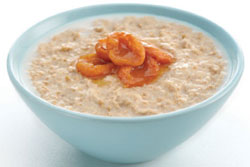
- 2 slices of bread (60g);
- 1 cup of cooked rice;
- 1 cup of cooked pasta;
- 1 medium bread roll;
- 1/2 cup of porridge or muesli; or
- 1 and 1/3 cups of cereal flakes.
Pregnant women should consume 5-6 serves of vegetables or legumes everyday. These serves should include vegetables which are leaves, roots, stems and seeds of plants as well as fruits such as tomatoes and pumpkin which are used like vegetables (e.g. in cooking and salad). Pregnant women should eat a variety of vegetables each day, including dark and light leafy vegetables, orange and starchy vegetables and legumes. Examples of foods which are equivalent to a single serving of vegetables include:
- 1/2 cup of cooked vegetables;
- 1/2 cup of cooked beans or legumes;
- 1 cup of raw salad vegetables; or
- 1 small potato.
Pregnant women need to eat more fruit than non-pregnant women and it is recommended that they consume 4 serves of fruit each day. Fresh, canned, juiced or dried fruit can all be consumed, although the majority of serves should be fresh fruit. A variety of types of fruit should be eaten, for example melons, stone fruit, citrus and tropical fruit. Examples of fruits which are equivalent to a single serve include:
- 1 medium piece of fruit, for example an apple, banana or pear;
- 2 small pieces of fruit, for example kiwi fruits, apricots or plums;
- 1 cup of fresh diced fruit (e.g. pineapple) or canned fruit;
- 1/2 cup of fruit juice; or
- Equivalent quantities of dried fruit (e.g. 4 dried apricot halves equal 2 small apricots).

- 1 cup of milk;
- 1/2 cup of evaporated milk;
- 40g hard cheese (soft cheeses should be avoided as they increase the risk of infection); or
- 200g (a small carton) of yoghurt.
Individuals who do not consume dairy products because of intolerance or personal choice may alternatively consume:
- 1 cup of soy milk (containing at least 100mg calcium per 100ml);
- 1 cup of almonds;
- 5 sardines; or
- 1/2 cup of pink salmon with bones.
Meat or other protein containing foods
Pregnant women should continue to consume 1 serve of meat or other protein containing foods each day. Meat and protein containing foods which are equivalent to a single serve include:
- 65-100g of cooked lean meat or chicken (fatty meat should be avoided to reduce the total fat content of the diet);
- 80-120g of cooked fish fillet;
- 2 small eggs;
- 1 cup of cooked legumes;
- 1/3 cup of nuts; or
- 1 cup of sesame seeds.
Fats and sugars should be eaten only in small quantities during pregnancy.
 |
More information on Dental Health and Nutrition in Pregnancy. |
It is also important for pregnant women to drink plenty of water, as water is an essential nutrient and demand for water increases during pregnancy. It is recommended that women drink at least 8 glasses of water each day during pregnancy.
Healthy eating to meet macronutrient requirements

Energy and weight gain during pregnancy
Maintaining adequate energy intake during pregnancy is important to ensure that the body has sufficient energy for maintenance, pregnancy related growth and physical activity. As a woman gains weight during pregnancy, her energy requirements increase with increasing weight gain.
Normal weight women (women with a BMI 18.5-25) who consume a healthy balanced diet should expect to gain 1.6kg in the first trimester of pregnancy and 0.44kg per week thereafter. Overall, an average weight gain of 12.5 kg is expected for a normal weight woman (BMI 22.5kg/m2) who bears an infant weighing 3.4kg. However, gestational weight gain varies from woman to woman depending on pre-pregnancy BMI. Women who are already overweight before pregnancy typically gain less weight, while those who are underweight prior to conception will gain weight at a faster rate. Women bearing multiple pregnancies may have greater weight gain.
Weight gain is an important indicator of good nutrition and foetal development during pregnancy. Extra blood volume, enlargement of the breasts and growth of the placenta and uterus will necessarily increase weight. Maternal weight gain of less than 10kg by 40 weeks of gestation is a risk factor for intrauterine growth restriction (IUGR).
 |
More information on Importance of Nutrition Before and During Pregnancy. |
Correcting misconceptions about weight gain during pregnancy
For fear of delivering large babies, some women purposely restrict their food intake whilst pregnant. This may be particularly true for women who have immigrated to Australia from countries where cultural beliefs about eating are very different. However, there are no benefits to a woman or her growing baby’s health associated with restricting food intake in pregnancy. On the contrary, not eating enough is associated with numerous health risks. Women should therefore avoid restricting their food intake, due to the numerous health risks it entails.
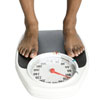 |
More information on How Much Weight to Gain During Pregnancy. |
More information
 |
For more information about pregnancy, including preconception advice, stages of pregnancy, investigations, complications, living with pregnancy and birth, see Pregnancy. |
 |
For more information on nutrition, including information on types and composition of food, nutrition and people, conditions related to nutrition, and diets and recipes, as well as some useful videos and tools, see Nutrition. |
References
- Panel on Macronutrients & Standing Committee for the Scientific Evaluation of Dietary Reference Intakes. Energy. Chapter 5. Dietary Reference Intakes for Energy, Carbohydrate, Fiber, Fat, Fatty Acids, Cholesterol, Protein and Amino Acids (Macronutrients), National Academy of Sciences. 2005. [cited 2009, June 6], Available from http://www.nap.edu/catalog/10490.html
- National Health and Medical Research Council. Dietary guidelines for Australian Adults. 2003. [cited 2010, January 20]. Available from: http://www.nhmrc.gov.au/publications/synopses/dietsyn.htm
- National Institute for Health and Clinical Excellence. Improving the health and nutrition of pregnant and breastfeeding mothers and children in low-income households. 2008. [cited 2009, August 22], Available from: www.nice.org.uk/PH011
- Villar J, de Onis M, Kestler E, Bolanos F, Cerezo R, Berendes HW. The differential morbidity of the intrauterine growth retardation syndrome. Am. J. Obstet. Gynecol 1990;163:151-7.
- Kramer MS. Intrauterine growth and gestational duration determinants. Pediatrics 1987; 80: 502-11
- McCormick MC. The contribution of low birth weight to infant mortality and childhood mortality. N Engl J Med 1985; 312: 82-90.
- Balcazar H, Haas ID. Retarded fetal growth patterns and early neonatal mortality in a Mexico city population. Bull Pan. Am. Health Organ 1991; 25: 55-63.
- Harvey D, Prince J, Burton J, Parkinson C, Campbell S. Abilities of children who were small-for-gestational-age babies. Pediatrics 1982; 69: 296-300
- Sub commission on Nutrition. 4th Report on the World Nutrition Situation: Nutrition throughout the lifecycle. 2000. [accessed 2009, November 11]. Available from: http://collections.infocollections.org/ukedu/en/d/Jh1313e/
- Department of Health and Ageing. Healthy eating at various life stages- pregnant women. 2009. [cited 2010, May 1]. Available from: http://www.health.gov.au/internet/healthyactive/publishing.nsf/Content/pregnant-women
- Academy for Educational Development. Maternal nutrition during pregnancy and lactation. 2004. [cited 2010, May 2]. Available from: http://www.pronutrition.org/files/MaternalNutritionDietaryGuide.pdf
- Food Standards of Australia and New Zealand, Australian Nutrient Database. 2007 [cited 2009, May 11] available at: http://www.foodstandards.gov.au/monitoringandsurveillance/foodcompositionprogram/ausnutspecialedition1332.cfm
- National Institute of Health. Fit for two- Tips for pregnancy. 2009. [cited 2010, May 1]. Available from: http://www.win.niddk.nih.gov/publications/two.htm#whatis
- Department of Health and Ageing. The Australian Guide to Healthy Eating- Background information for consumers. 1998. [cited 2010, May 1]. Available from: http://www.health.gov.au/internet/main/publishing.nsf/Content/E384CFA588B74377CA256F190004059B/$File/fd-cons.pdf
- The Royal Australian College of General Practitioners: Weight problems and pregnancy [online]. RACGP, 2009 [cited 2010 July 20]. Available from URL: http://www.racgp.org.au/familyhealth/Weight_problems_and_pregnancy_women
- Brown, J. Carlson, M. Nutrition and multi-fetal pregnancy. J Am Diet Assoc. 2000; 100(3): 343-8.
- Creasy RK, Resnik R. Intrauterine growth restriction. Maternal-fetal medicine: Principles and Practice. Philadelphia: Saunders, 1994: 558-74.
- Ogunjuyibe, P. Ojofeitimi, E. Sanusi, R. Food aversion during pregnancy: a major cause of poor pregnancy outcomes. J Chinese Clin Med. 2008; 3(7): 389-97.
All content and media on the HealthEngine Blog is created and published online for informational purposes only. It is not intended to be a substitute for professional medical advice and should not be relied on as health or personal advice. Always seek the guidance of your doctor or other qualified health professional with any questions you may have regarding your health or a medical condition. Never disregard the advice of a medical professional, or delay in seeking it because of something you have read on this Website. If you think you may have a medical emergency, call your doctor, go to the nearest hospital emergency department, or call the emergency services immediately.

